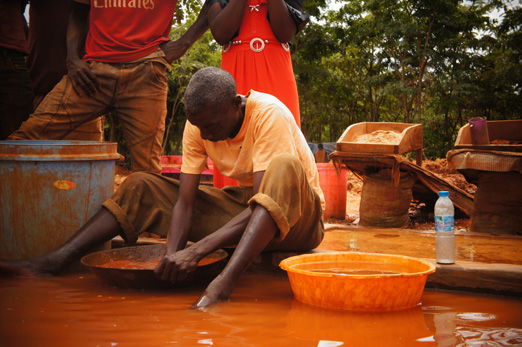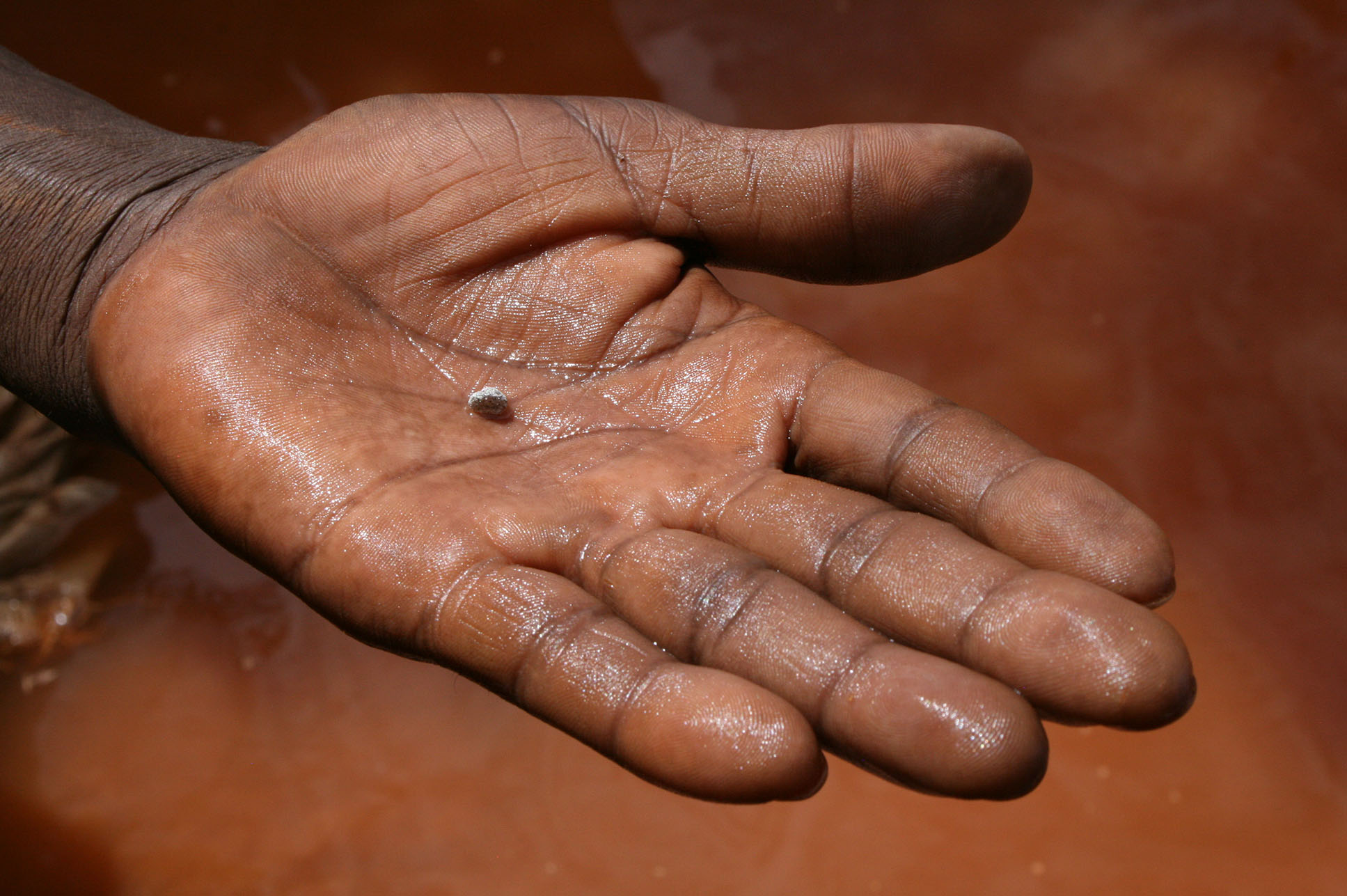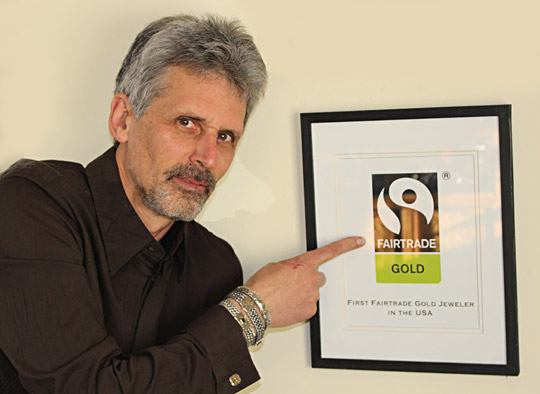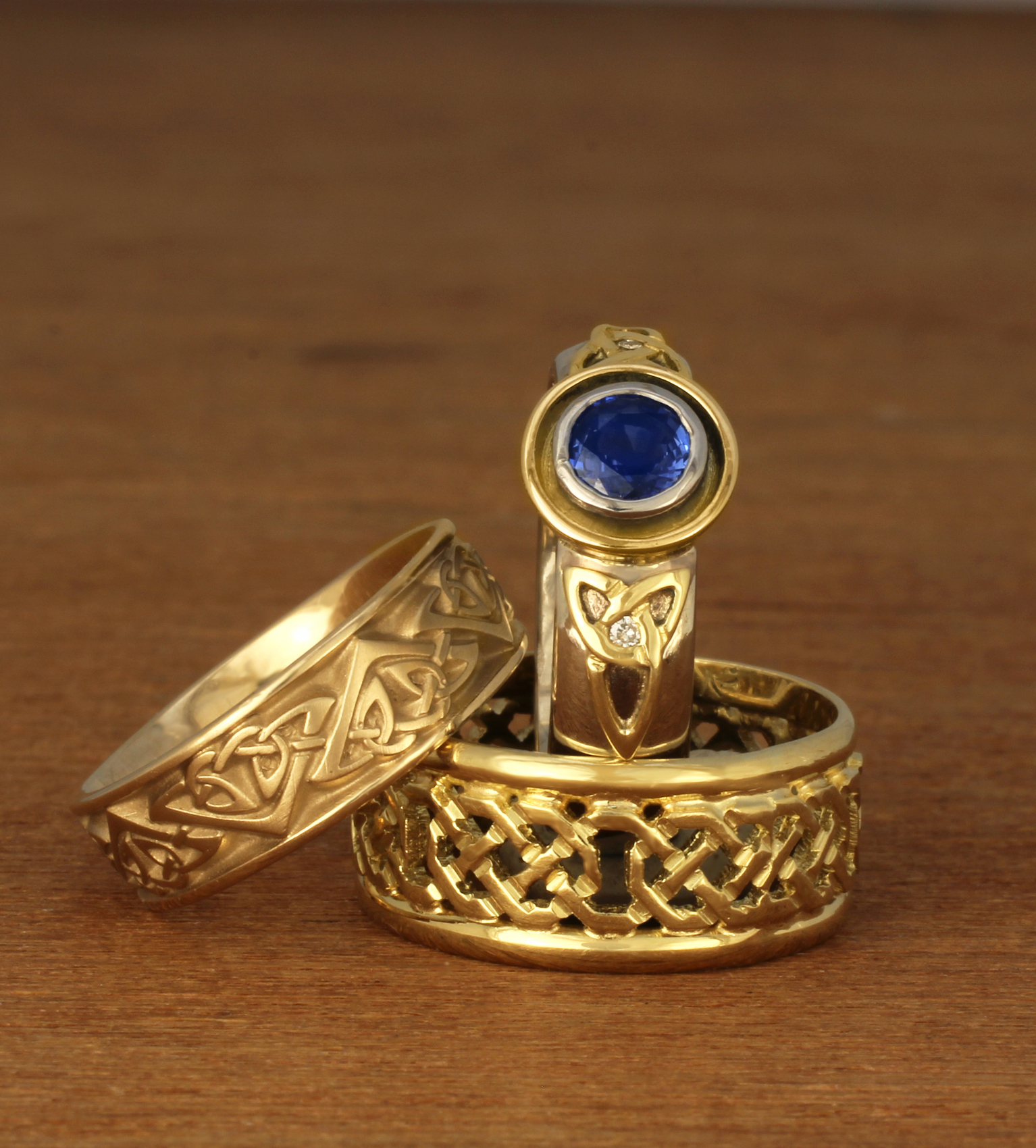Fairtrade Gold is an artisanal product of small-scale miners—whose primary tools are generally the shovel and pick. For Fairtrade Gold, environmental and labor conditions are audited— and this gold is transparently traceable directly to the community that mines it.
Fairtrade Gold also provides a social premium that allows miners to improve quality-of-life conditions for themselves and others in their communities.
Fairtrade Gold has one other advantage. Unlike other ethical gold from small-scale miners, the jeweler’s use of gold is also audited. This auditing is part of the contractual arrangement with Fairtrade International that allows the jeweler use of its logo, a widely respected brand.
"Essentially, when you add up the Fairtrade premiums, import charges, supply house upcharges, and auditing fees, Fairtrade Gold costs about 20% more than recycled gold. Labor costs can add an additional 60%."

The bottom line: with Fairtrade Gold, the people of the land control and benefit from the resources of the land. And you as a consumer can be completely confident that you are making a huge difference to certified mining communities and purchasing the most precious gold in the world.
However, Fairtrade Gold does cost more than ‘dirty gold’ or ‘greenwashed’ recycled gold.
If gold were $1000 an ounce, recycled/dirty gold from your typical jeweler costs the jeweler $1020 per ounce. Fairtrade Gold costs $1200 to $1250 per ounce.
Here’s a quick summary of cost:
Cost of Fairtrade Gold
Here is a ‘back of the envelope’ calculation. The numbers vary according to circumstances, and I have also rounded number so we’re not dealing with fractions in the total. Nevertheless, the figures still give you a close approximation of the actual costing.
It all starts with daily spot price, the international ‘fix’ which determines the pricing at any given moment.
Fairtrade Gold is purchased from the mine between 95% and 98% of the daily spot. Lately, the gold I have been using has been purchased at the 99%, so I’m going to use that as a basis for my calculations:
99%: Gold purchased from miners at daily spot price.
+ 5% = 104%: Fairtrade premium.
+ 1% = 105%: Shipping charges.
+ 1% = 106%: Charge from refiner to bring the gold from miners to .999 pure.
+ 2% = 108%: Charge from importer.
+ 9% to 14% = 117% to 122% : Up-charge from metal supply house to jeweler.
+ 4% = 121% to 126%: FLOCert charges for auditing supply chain.
Additional Labor In Making Fairtrade Gold Wedding Rings
There's an additional expense even outside the gold particularly in context to wedding rings.
Since we do not have a supply chain that can produce mill products in Fairtrade gold, we have to fabricate gold wire and sheet from scratch. This is a time consuming, clostly process that can add hours of time to making even a simple ring.
For example, in making a wedding ring from recycled gold, we can order the gold wire in the shape and width that we want. Making the ring is a relatively simply process. With Fairtrade gold, we have to start from 24K gold, which we then alloy. Then, we create an ingot. From there, we have to put it through a rolling mill and create gold wire. This wire, then, is hand fabricated into the exact shape and size of the ring.
If it is too thick or wide, we have to take the excess gold out which is an additional loss. If you want to see what this means in practice, check out the series of steps shown in this article: Making A Fairtrade Gold Wedding Ring in 11 Steps.
Read on for a more detailed explanation of this costing, and for more background information.
Source and Cost of Gold Used in Jewelry
Gold for jewelry comes from large and small-scale mining, as well as other sources such as recycled electronics and jewelry. This gold is sold to jewelry manufacturers at a small percentage above or below daily spot price, depending upon the volume.
In selling recycled or mined gold to jewelers, an average gold dealer takes 2% as a commission. For example, if gold were $1000 an ounce, a jeweler might pay $1020 per ounce. Again, this percentage can vary according to volume.
Whether gold is newly mined or from recycled sources does not affect its price.
Recycled gold is basically the brother of ‘Dirty Gold.’ It comes electronics or old jewelry originally was sourced from dirty gold mines. It is simply refined and rebranded as ‘eco-gold.’ Unlike Fairtrade Gold, is not an environmental or socially-responsible choice, because it does not reduce in any way the mining currently taking place.
(This may seem counter-intuitive, but read our article for more on the issue.)
Gold From Small Scale Mining and Mercury Pollution
Fairtrade Gold comes from small-scale mining, which generates about 20% of the world’s gold supply.
Typically, small-scale mining is terrible for communities and the environment. Gold is obtained through mixing gold dust and water with mercury, as shown in these photos, which I took in Tanzania:

Mercury binds to the gold in the dirt and water.

This photo shows gold mixed with mercury that remained from the process shown in the previous photo.
This miner will probably take this mercury and burn it off in a frying pan, creating methylmercury, one of the most dangerous neurotoxins known to man. Small-scale gold mining is the world’s largest contributor of anthropogenic mercury emissions (37%) in the world.
Small Scale Mining and Poverty
Mercury toxification is just one of the major concerns about unregulated small-scale gold mining, which makes up about 90% of the world’s gold mining labor.

Small-scale gold mining is very labor intensive, as this photo taken of a mine in Tanzania shows.
Small-scale miners typically live and work in remote areas, and usually have no way of determining how much their gold is worth. As a result, a small-scale miner will often sell the gold he or she gathers after a few days of hard work for just 70% of its international value.
This is often because these miners simply don’t know the spot price. Even if they do, the gold they mine is not pure (.999) gold, but a mixture of gold and other metals, such as silver or even platinum. The small-scale miner does not have the technical ability to analyze the purity of his or her gold.
Plus, because the quantity of gold being sold is small, this often means less money to miners than if they were selling in volume.
As a result, small-scale miners are locked into a poverty cycle. They do not make enough to do anything but survive.
Fairtrade Gold’s Impact
Small-scale mining has excellent potential for alleviating poverty if the miners can be supported to mine responsibly.
Under the Fairtrade Gold system, gold is purchased from small-scale miners for 95% to 98% of its international spot value, rather than just 70%.
Also, the gold is accumulated until there is a level of volume which makes it viable to import. The hand-to-mouth cycle of selling a few dollars worth of gold as soon as it is mined is broken. Miners receive a salary for their work in their small-scale mining organization, which can be a cooperative or a small business.
Additionally, there is a premium of $2000 per kilo of gold paid directly to the mining community. How this premium is used in the community is determined democratically. In Sotrami, where we at Reflective Jewelry have purchased much of our Fairtrade Gold, the premium has been used for elder care, computers, and to open a community market.

Marc Choyt, President of Reflective Jewelry, poses with his Fairtrade Gold certification.
A Detailed Review of Fairtrade Gold Costing
Now that you understand a little bit about the process of Fairtrade Gold versus other gold offered on the market, we can expand on what we mentioned at the onset of this article— the breakdown of pricing. We start with the cost of gold being purchased from the mine, and add percentage points to that spot price as the gold reaches the small jeweler.
99%: Gold purchased from miners at daily spot price. This is what the miners are charging the importers.
+ 5% = 104%: This is for the for the Fairtrade premium. A kilo of gold at spot price (at the time of this article being written) is approximately $42,000. The $2000 premium increases the price of gold from the mine by almost 5%. So, someone purchasing Fairtrade Gold from a mine in volume might end up paying 103% of spot price to the miners.
+ 1% = 105%: Shipping charges. This is what it costs, approximately, to ship and export. But this is just an estimate. The cost can go up or down, depending on the volume of the import.
+ 1% = 106%: Refining costs. Remember, gold from a mine is not pure gold. It’s mixed with other metals. This is the charge of the refiner to bring the gold from miners to .999 pure.
+ 2% = 109%: Charge from importer, who goes through all the paperwork and hassle to bring the gold into the EU or USA. This is an extremely difficult logistical challenge. It involves relationships with the miners, and setting up contacts with the right brokerage houses. Initially, it is a money-losing proposition because often the first imports are of too small a volume.
+ 9% to 14% = 117% to 122%: Up-charge from metal supply house to jeweler. The supply houses that sell the gold to jewelers purchase from the importer in volume and then mark up the price.
+ 4% = 121% to 126%: A certified Fairtrade Gold jeweler pays a $1.80-per-gram charge to FLOCert, the agency which traces Fairtrade Gold from mine to market and audits for ethical standards. FLOCert uses this money to pay for audits at the retail and mining end. There are 31 grams in a troy ounce of gold, meaning the FLOCert fee adds an additional $51 to the price of an ounce of Fairtrade Gold.
Here’s the Bottom Line:
If gold were $1000 an ounce, dirty gold that supplies the jewelry sector and recycled gold would sell for $1020 an ounce.
Fairtrade Gold would sell for $1150 to $1240 an ounce to the average small who cannot buy in volume, purchasing from a jewelry supply house.
Additional Costs for Fairtrade Gold
There are additional costs for any jewelry company in handling Fairtrade Gold. As I explained at the beginning of this article, we have to make gold mill products by hand instead of ordering them.
Also, we are required to tack and trace Fairtrade Gold through their inventory system for FLOCert. After three years, they sent someone to our shop and reviewed our paperwork and we passed. So, just being part of this system involves a lot of extra paperwork, in addition to developing new systems that track Fairtrade Gold, keeping it separate from other gold in the system.
We have also have had to pay extra in casting costs. For example, a typical simple gold wedding ring can be made through mass production, but when we cast a Fairtrade white gold ring, it is a single boutique item. Even simple projects become custom projects.
Additionally, as pioneers in the US, we have been subject to unexpected supply delays and numerous obstacles— including cash flow issues, having to stock about an extra fifteen ounces of gold because of the irregularlity of the supply chain. If we were not using Fairtrade gold, we could order the gold as we needed it instead of having to finance it. of extra gold in our company because of the irregular being forced to indirectly purchase Fairtrade Gold from England, being subject to, and struggling to make sheet and wire products that would otherwise be easily available. (Such gold ‘mill products’ were not, until very recently, available in Fairtrade Gold.)
The cost has been more than just time and money— it also manifests in stress, particularly in the beginning. Though we officially joined the FLO Cert in April, 2015, we actually starting making rings in Fairtrade Gold back in 2011. Trying to implement a new product with very little supply chain or logistical support is extremely risky. In the early years we were subject to working under tight deadlines while dealing with erroneous import charges, unanticipated delays and expensive shipping under the stres of tight wedding ring deadline.
We have absorbed most of these extra these extra costs, personal and financial, because Fairtrade Gold is the product most likely to benefit millions of small scale producers and people like you who care.

Why Purchase Fairtrade Gold?
From a business perspective, Fairtrade Gold does not make much sense. But from every other humanistic perspective, it is the only gold that make sense.
Recycled gold and newly-mined gold is the same gold. Gold mining, whether from large mines or small scale sources, creates massive environmental destruction and has terrible social costs.
Fairtrade Gold offers the best chance for small scale miners to work their way out of exploitation and poverty. This equates to less mercury in our environment, empowered communities and stronger local economies.
As a customer, Fairtrade Gold gives you the opportunity to purchase a wedding or engagement ring that creates a more beautiful world we all know is possible.
For jewelry, Fairtrade Gold is simply the best gold to use.
Marc Choyt is president of Reflective Jewelry, a designer jewelry company founded in 1995. He pioneered the ethical sourcing movement in North America and is also the only certified Fairtrade Gold jeweler in the United States. Choyt’s company was named Santa Fe New Mexico’s Green Business of the Year in 2019, and he has been honored with several awards for his efforts to support ethical jewelry. His ebook, Ethical Jewelry Exposé: Lies, Damn Lies and Conflict Free Diamonds, is available online. Choyt can be reached on Twitter at @Circlemanifesto or by email at marc(at)reflectivejewelry.com.